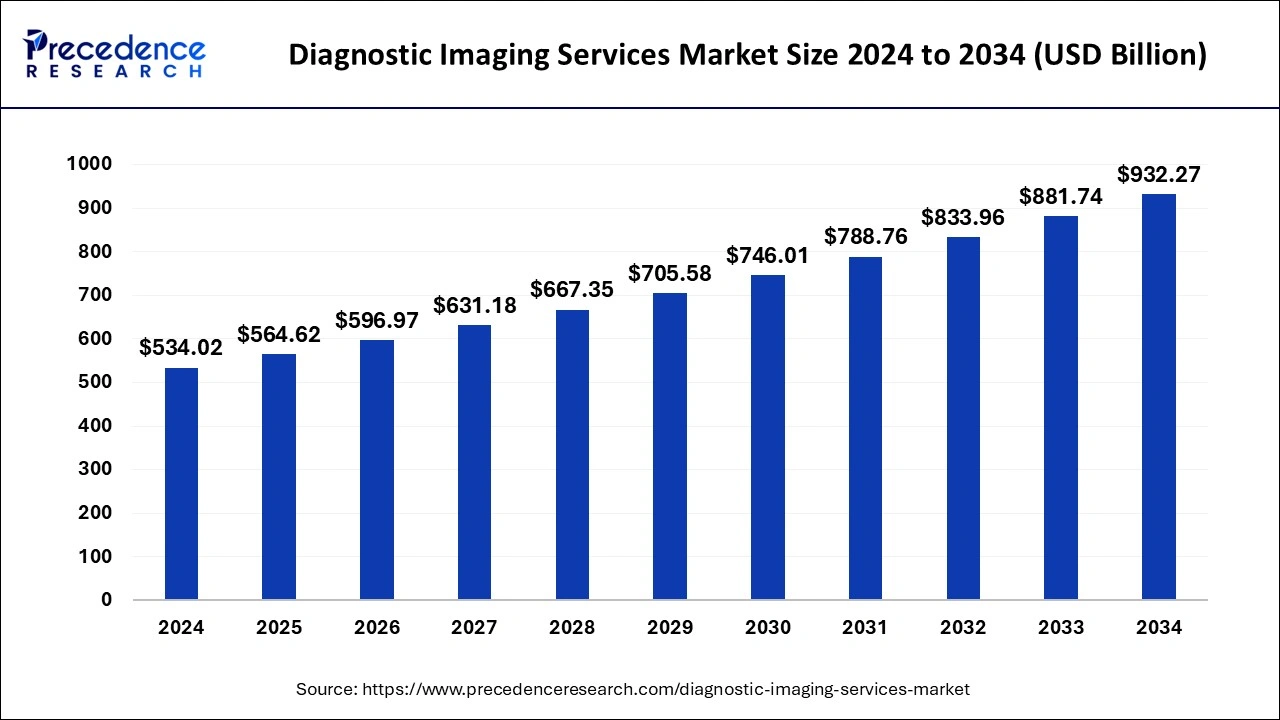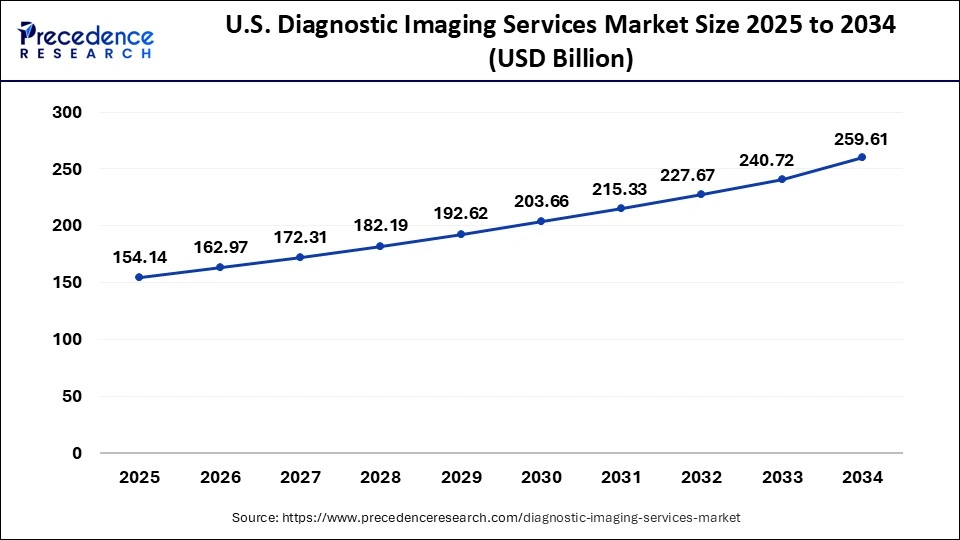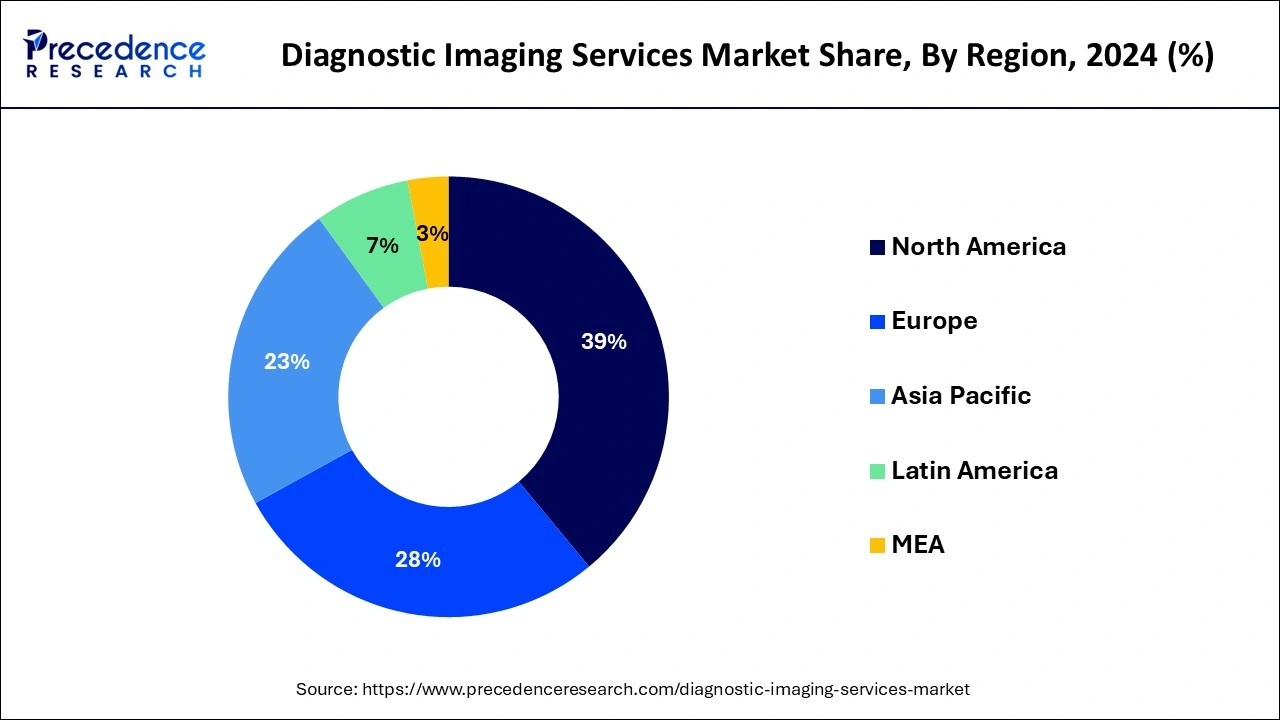August 2024
The global diagnostic imaging services market size is calculated at USD 564.62 billion in 2025 and is forecasted to reach around USD 932.27 billion by 2034, accelerating at a CAGR of 5.73% from 2025 to 2034. The North America market size surpassed USD 208.27 billion in 2024 and is expanding at a CAGR of 5.86% during the forecast period. The market sizing and forecasts are revenue-based (USD Million/Billion), with 2024 as the base year.
The global diagnostic imaging services market size accounted for USD 534.02 billion in 2024 and is expected to exceed USD 932.27 billion by 2034, growing at a CAGR of 5.73% from 2025 to 2034. The market growth is driven by the rising awareness about early disease diagnosis and prevention.

AI-driven algorithms and deep learning models allow radiologists to interpret medical images rapidly and accurately. AI-driven imaging tools help detect diseases, such as tumors, fractures, or infections, in a precise manner that cannot be easily identified through any other means. These AI-driven tools enhance productivity in handling different tasks by reducing the time consumed in image processing and the time devoted to the patient. Moreover, artificial intelligence makes picture analysis more accurate and consistent, and the driven error range is reduced. These advancements not only enhance diagnostic results but also help reduce treatment costs since early diagnosis helps in disease prevention, which reduces future risks.
The U.S. diagnostic imaging services market size was exhibited at USD 145.79 billion in 2024 and is projected to be worth around USD 259.61 billion by 2034, growing at a CAGR of 5.94% from 2025 to 2034.

North America dominated the diagnostic imaging services market in 2024. The rising prevalence of chronic diseases such as cancer, diabetes, arthritis, and other chronic disorders has created profitable growth prospects for the diagnostic imaging services market.

Asia-Pacific, on the other hand, is expected to develop at the fastest rate during the forecast period. The growing number of diagnostic imaging system market players and companies in the region is boosting the diagnostic imaging services market’s overall growth.
Diagnostic imaging is a critical component of many healthcare industries around the world. Imaging services are used to diagnose and treat a wide range of chronic and infectious diseases. The diagnostic imaging services entail the diagnosis and generation of images of various parts of the human body, with the goal of better understanding the patient's condition. CT scans, X-rays, MRI, ultrasonic, and endoscopy are just a few of the diagnostic imaging services available. The visual representation of detailed imaging of human body parts has significantly improved overall treatment and success rate. As a result, the diagnostic Imaging services market is expected to grow at a faster rate during the forecast period, owing to rising public awareness of the importance of early detection of health problems.
The demand for diagnostic imaging services has been steadily increasing as the geriatric population pool grows each year. The elderly are twice or three times more likely than the younger population to undergo diagnostic imaging. Diagnostic imaging is critical for detecting life-threatening diseases such as cancer. Furthermore, diagnostic imaging can detect life-threatening infectious diseases such as the recently discovered coronavirus.
| Report Coverage | Details |
| Market Size in 2025 | USD 564.62 Billion |
| Market Size in 2034 | USD 932.27 Billion |
| Growth Rate | CAGR of 5.73% from 2025 to 2034 |
| Largest Market | North America |
| Fastest Growing Market | Asia Pacific |
| Base Year | 2024 |
| Forecast Period | 2025 to 2034 |
| Segments Covered | Modality, End User, Region |
Rising Prevalence of Chronic Diseases
The rising prevalence of chronic diseases, such as cancer, cardiovascular disorders, and diabetes, is expected to drive the demand for diagnostic imaging services. There is a need to diagnose these conditions early and accurately when they occur more frequently around the world. magnetic resonance imaging, computed tomography scan, and X-rays are commonly used diagnostic procedures in identifying stages and progress of chronic diseases. The use of these technologies leads to early diagnosis, which leads to enhanced treatment and patient care. As the burden of chronic diseases increases, so does the demand for diagnostic imaging services. According to the World Health Organization (WHO), chronic diseases are estimated to be responsible for nearly 74% of deaths yearly, thus boosting the demand for diagnostic imaging solutions.
High Cost of Imaging Equipment
The high cost of diagnostic imaging equipment is expected to hamper the growth of the market. Although useful in diagnosing diseases and body injuries, MRI and CT scanners are expensive, which puts tremendous pressure on healthcare providers, mostly in low and middle-income countries. Hospitals and diagnostic centers face challenges in terms of finances required to buy, maintain, and replace or upgrade the equipment. Small and medium healthcare facilities find it difficult to invest in the latest imaging technologies, thereby hindering the market growth.
Growing Investments in Developing Advanced Imaging Technologies
With the rising demand for advanced imaging technologies, hospitals and health agencies are investing heavily in developing advanced imaging tools, which is anticipated to create significant opportunities in the diagnostic imaging sector. Advanced techniques such as 3D imaging, functional MRI, and digital mammography have higher reliability and faster results. The use of these technologies extends into the healthcare sector because it exalts patient satisfaction and operation. There is potential in introducing new state-of-the-art imaging systems, given that many emerging markets continue to develop the strength of their healthcare systems. Furthermore, sophisticated diagnostic devices enable screening for early diseases and facilitate management, thus fuelling the market.
In 2024, X-ray had the highest market share of the diagnostic imaging services market. For numerous tests and operations, X-ray is one of the most popular main medical imaging modalities. This service provides noninvasive disease diagnosis and monitoring, as well as assistance in surgical treatment planning.
On the other hand, the CT scan segment is expected to expand significantly during the forecast period. This imaging modality’s primary benefit is that it allows for simultaneous detailed imaging of blood vessels, bone, and soft tissues.
Due to the rising prevalence of various ailments such as cancer and cardiac disorders, hospitals dominate the diagnostic imaging services market in 2024.
On the other hand, the diagnostic imaging centers is expected to grow at a rapid pace. The overall growth of the segment is projected to be influenced by the availability of several imaging modalities in a single facility and reimbursement policies for imaging operations.
By Modality
By End Use
By Geography
For inquiries regarding discounts, bulk purchases, or customization requests, please contact us at sales@precedenceresearch.com
No cookie-cutter, only authentic analysis – take the 1st step to become a Precedence Research client
August 2024
January 2025
January 2025
February 2025